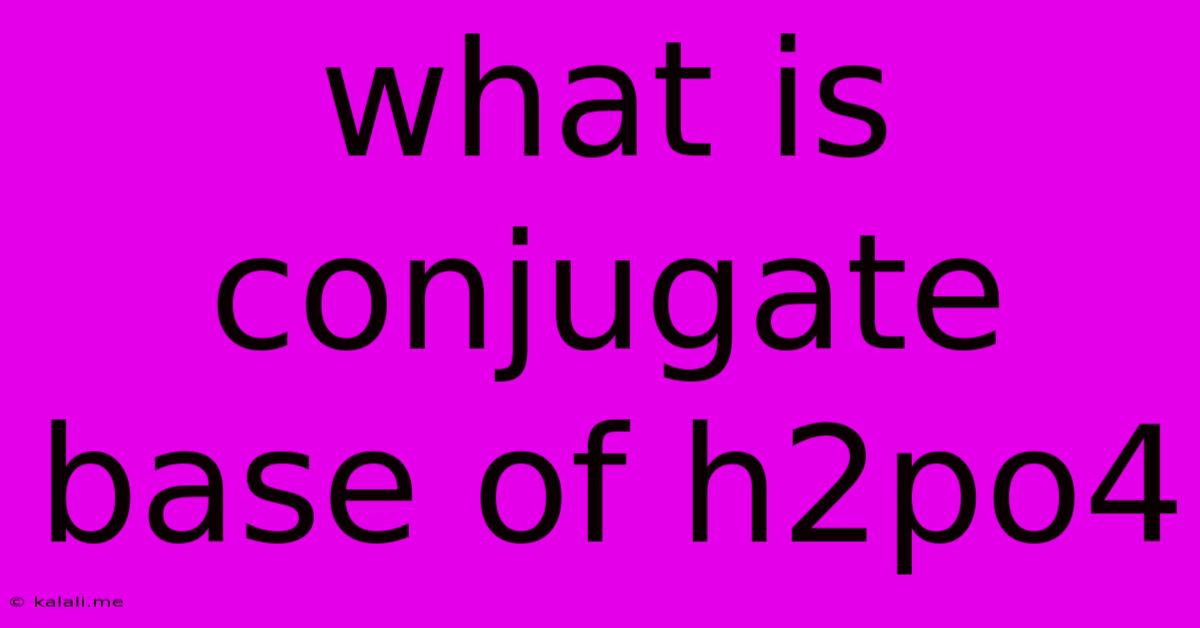What Is Conjugate Base Of H2po4
Kalali
Jun 14, 2025 · 3 min read

Table of Contents
What is the Conjugate Base of H₂PO₄⁻? Understanding Acid-Base Conjugates
Understanding conjugate acid-base pairs is fundamental to grasping acid-base chemistry. This article will clearly explain what the conjugate base of H₂PO₄⁻ is, providing a detailed explanation and exploring the broader context of conjugate pairs within the Brønsted-Lowry acid-base theory. This will help you to better understand the behavior of phosphoric acid and its related species in various chemical environments.
The dihydrogen phosphate ion, H₂PO₄⁻, acts as a weak acid. This means it partially dissociates in water, releasing a proton (H⁺). According to the Brønsted-Lowry theory, an acid is a proton donor, and a base is a proton acceptor. When an acid donates a proton, it forms its conjugate base. Conversely, when a base accepts a proton, it forms its conjugate acid.
Defining Conjugate Acid-Base Pairs
A conjugate acid-base pair differs only by a single proton (H⁺). To find the conjugate base of an acid, simply remove one proton. Let's apply this to H₂PO₄⁻.
Identifying the Conjugate Base of H₂PO₄⁻
Removing one proton (H⁺) from H₂PO₄⁻ leaves us with HPO₄²⁻, the hydrogen phosphate ion. Therefore, the conjugate base of H₂PO₄⁻ is HPO₄²⁻.
Understanding the Equilibrium
The relationship between H₂PO₄⁻ and its conjugate base HPO₄²⁻ is an equilibrium reaction in aqueous solution:
H₂PO₄⁻ (aq) ⇌ H⁺ (aq) + HPO₄²⁻ (aq)
This equilibrium is governed by the acid dissociation constant, Ka, for H₂PO₄⁻. The value of Ka indicates the strength of the acid; a smaller Ka value indicates a weaker acid.
Phosphoric Acid and its Conjugate Bases
It's important to note that H₂PO₄⁻ itself is the conjugate base of phosphoric acid (H₃PO₄). Phosphoric acid is a triprotic acid, meaning it can donate three protons. This leads to a series of conjugate acid-base pairs:
- H₃PO₄ (phosphoric acid) / H₂PO₄⁻ (dihydrogen phosphate ion)
- H₂PO₄⁻ (dihydrogen phosphate ion) / HPO₄²⁻ (hydrogen phosphate ion)
- HPO₄²⁻ (hydrogen phosphate ion) / PO₄³⁻ (phosphate ion)
Each step of the dissociation has its own Ka value, reflecting the decreasing acidity as successive protons are lost.
Practical Applications
Understanding conjugate acid-base pairs, including the conjugate base of H₂PO₄⁻, is crucial in various fields:
- Buffer Solutions: Mixtures of a weak acid and its conjugate base (like H₂PO₄⁻ and HPO₄²⁻) create buffer solutions, resisting changes in pH. This is vital in biological systems and chemical processes.
- Titrations: Knowing the conjugate base is essential for calculating the pH at different points during an acid-base titration.
- Biochemistry: Phosphate ions and their conjugate acids play critical roles in many biological processes, including energy transfer (ATP) and DNA structure.
In conclusion, the conjugate base of H₂PO₄⁻ is HPO₄²⁻. Understanding this relationship and the broader concept of conjugate acid-base pairs is fundamental to comprehending acid-base chemistry and its diverse applications. This knowledge is vital for students and professionals alike working in chemistry, biochemistry, and related fields.
Latest Posts
Latest Posts
-
Compound Interest Formula Excel Between Two Dates
Jun 15, 2025
-
Difference Between Winter And Summer Olympics
Jun 15, 2025
-
The Missing Number In The Series 1 4 27
Jun 15, 2025
-
Least Common Multiple Of 60 And 72
Jun 15, 2025
-
What Is The Unit Of The Coefficient Of Friction
Jun 15, 2025
Related Post
Thank you for visiting our website which covers about What Is Conjugate Base Of H2po4 . We hope the information provided has been useful to you. Feel free to contact us if you have any questions or need further assistance. See you next time and don't miss to bookmark.